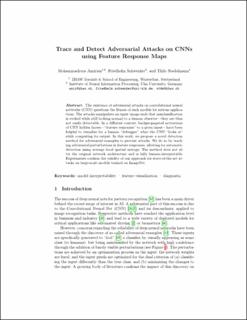Bitte benutzen Sie diese Kennung, um auf die Ressource zu verweisen:
https://doi.org/10.21256/zhaw-3863| Publikationstyp: | Konferenz: Paper |
| Art der Begutachtung: | Peer review (Publikation) |
| Titel: | Trace and detect adversarial attacks on CNNs using feature response maps |
| Autor/-in: | Amirian, Mohammadreza Schwenker, Friedhelm Stadelmann, Thilo |
| DOI: | 10.1007/978-3-319-99978-4_27 10.21256/zhaw-3863 |
| Tagungsband: | Artificial Neural Networks in Pattern Recognition |
| Seite(n): | 346 |
| Seiten bis: | 358 |
| Angaben zur Konferenz: | 8th IAPR TC3 Workshop on Artificial Neural Networks in Pattern Recognition (ANNPR), Siena, Italy, 19-21 September 2018 |
| Erscheinungsdatum: | 2018 |
| Reihe: | Lecture Notes in Computer Science |
| Reihenzählung: | 11081 |
| Verlag / Hrsg. Institution: | Springer |
| ISBN: | 978-3-319-99977-7 978-3-319-99978-4 |
| Sprache: | Englisch |
| Schlagwörter: | Model interpretability; Feature visualization; Diagnostic |
| Fachgebiet (DDC): | 005: Computerprogrammierung, Programme und Daten |
| Zusammenfassung: | The existence of adversarial attacks on convolutional neural networks (CNN) questions the fitness of such models for serious applications. The attacks manipulate an input image such that misclassification is evoked while still looking normal to a human observer – they are thus not easily detectable. In a different context, backpropagated activations of CNN hidden layers – “feature responses” to a given input – have been helpful to visualize for a human “debugger” what the CNN “looks at” while computing its output. In this work, we propose a novel detection method for adversarial examples to prevent attacks. We do so by tracking adversarial perturbations in feature responses, allowing for automatic detection using average local spatial entropy. The method does not alter the original network architecture and is fully human-interpretable. Experiments confirm the validity of our approach for state-of-the-art attacks on large-scale models trained on ImageNet. |
| URI: | https://digitalcollection.zhaw.ch/handle/11475/8027 |
| Volltext Version: | Akzeptierte Version |
| Lizenz (gemäss Verlagsvertrag): | Lizenz gemäss Verlagsvertrag |
| Departement: | School of Engineering |
| Organisationseinheit: | Institut für Informatik (InIT) |
| Publiziert im Rahmen des ZHAW-Projekts: | QualitAI - Quality control of industrial products via deep learning on images |
| Enthalten in den Sammlungen: | Publikationen School of Engineering |
Dateien zu dieser Ressource:
| Datei | Beschreibung | Größe | Format | |
|---|---|---|---|---|
| ANNPR_2018c.pdf | Accepted Version | 2.95 MB | Adobe PDF |  Öffnen/Anzeigen |
Zur Langanzeige
Amirian, M., Schwenker, F., & Stadelmann, T. (2018). Trace and detect adversarial attacks on CNNs using feature response maps [Conference paper]. Artificial Neural Networks in Pattern Recognition, 346–358. https://doi.org/10.1007/978-3-319-99978-4_27
Amirian, M., Schwenker, F. and Stadelmann, T. (2018) ‘Trace and detect adversarial attacks on CNNs using feature response maps’, in Artificial Neural Networks in Pattern Recognition. Springer, pp. 346–358. Available at: https://doi.org/10.1007/978-3-319-99978-4_27.
M. Amirian, F. Schwenker, and T. Stadelmann, “Trace and detect adversarial attacks on CNNs using feature response maps,” in Artificial Neural Networks in Pattern Recognition, 2018, pp. 346–358. doi: 10.1007/978-3-319-99978-4_27.
AMIRIAN, Mohammadreza, Friedhelm SCHWENKER und Thilo STADELMANN, 2018. Trace and detect adversarial attacks on CNNs using feature response maps. In: Artificial Neural Networks in Pattern Recognition. Conference paper. Springer. 2018. S. 346–358. ISBN 978-3-319-99977-7
Amirian, Mohammadreza, Friedhelm Schwenker, and Thilo Stadelmann. 2018. “Trace and Detect Adversarial Attacks on CNNs Using Feature Response Maps.” Conference paper. In Artificial Neural Networks in Pattern Recognition, 346–58. Springer. https://doi.org/10.1007/978-3-319-99978-4_27.
Amirian, Mohammadreza, et al. “Trace and Detect Adversarial Attacks on CNNs Using Feature Response Maps.” Artificial Neural Networks in Pattern Recognition, Springer, 2018, pp. 346–58, https://doi.org/10.1007/978-3-319-99978-4_27.
Alle Ressourcen in diesem Repository sind urheberrechtlich geschützt, soweit nicht anderweitig angezeigt.